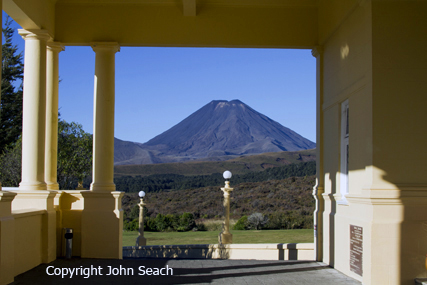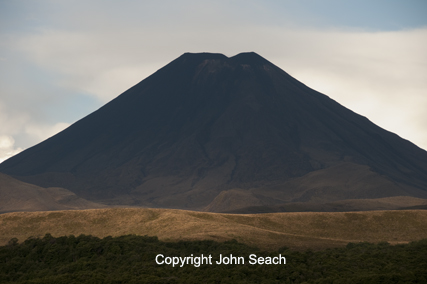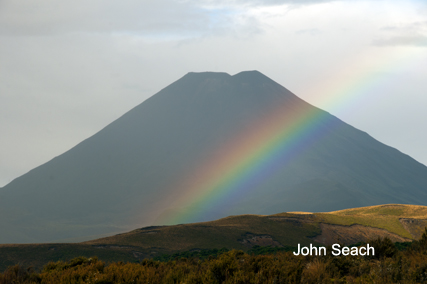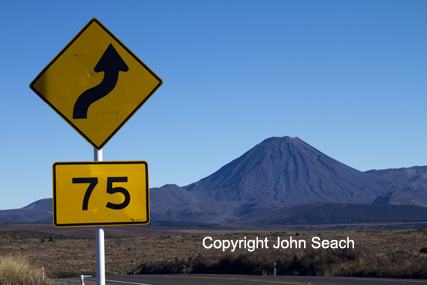Volcano Live
volcanolive.com
Ngauruhoe Volcano | Dr John Seach
Last updated: January 2026

North Island, New Zealand
39.16 S, 175.63 E
summit elevation 2291 m
Stratovolcano (part of Tongariro complex)
Ngauruhoe is a young cone with a 30 degree slope. The active vent is about 150 m wide crater of a scoria which formed on Ngauruhoe summit between 1954 and 1975. The cone is located within a 400 m wide, older crater. Ngauruhoe covers an area of 15 sq km and has a volume of 2.2 cubic km. The cone is well preserved and hasn't undergone significant mass wasting.
Eruptions at Ngauruhoe have rarely been more than nine years apart. The volcano has been quiet since 1975 - the longest break in activity in its recorded history. Eruptions at Ngauruhoe are noted for their diversity. No single eruption type dominates. A single eruption can exhibit several eruption styles. This is similar to Lopevi volcano in Vanuatu.
Warning: Sudden explosions can eject bombs and ash. Exclusion zones enforced during unrest; summit access hazardous. Hikers on Tongariro Crossing should check alerts.
Geology and Volcanology
Ngauruhoe is an andesitic stratovolcano and the most active vent of the Tongariro complex in recent centuries. It features a steep conical shape built within an older crater. Part of the Taupo Volcanic Zone, it erupts from a single summit crater with Strombolian to Vulcanian activity. Monitored by GeoNet with seismicity, deformation, and gas data.
Current Activity (January 2026)
Ngauruhoe remains quiet with no eruptive activity since 1977. Low seismicity and stable deformation. Minor fumarolic emissions possible. Part of Tongariro complex at low unrest (level 1). Hiking trails open with caution. Monitoring by GeoNet ongoing.
Ngauruhoe volcano photos by Dr John Seach

Ngauruhoe volcano - Dr John Seach (2011)

Ngauruhoe volcano - Dr John Seach

Ngauruhoe volcano from Tongariro alpine crossing

Ngauruhoe volcano - Dr John Seach
Post-1977 Quiescence (ongoing)
Longest recorded period of inactivity; low seismicity.
2006 Earthquakes
Ngauruhoe was raised to level 1 alert in June 2006 due to an increase in earthquakes under the volcano. Earthquakes peaked in early June at about 50/day. The location of the earthquakes were about 1 km beneath the N flank. Temperature and gas emission from the summit remained unchanged. The maximum fumarole temperature near the summit was about 85 C.
1975 Eruptions
On 19th February 1975 an eruption produced pyroclastic flows and a 10 km high ash plume. Blocks were ejected 2.8 km from the vent at velocities up to 400 m/s.
1974 Eruption
Explosive activity occurred at Ngauruhoe volcano between 27-30 March 1974. The activity lasted for a few hours and produced a cloud which reached altitude of 6000 m. Some incandescent blocks fell close to the cone. A study of eruptions from 1972-74 showed that a significant number were grouped around the fortnightly earth tidal maximum.
1973 Eruption
A new period of magmatic eruptions began at Ngauruhoe volcano on 2nd January 1973. Further small eruptions occurred in September and October.
1969 Eruption
An explosive eruption occurred on 3 February 1969 with ash emissions reaching an altitude of 15,000 ft.
1954-1955 Eruptions
Strombolian eruptions occurred at Ngauruhoe volcano on 4th June 1954 after ash and block emissions for the previous few weeks. Over a period of 4 months at least 10 aa lava flows occurred. Eruptions ceased during September 1954 then resumed between December 1954 and March 1955. Atmospheric shock waves were observed in 1954.
1949 Eruption
An eruption of Ngauruhoe volcano began on 9th February 1949 after an hour of tremor. At the beginning of the eruption the crater filled with lava and overflowed the northwest side of the cone. Pyroclastic avalanches moved over a mile down NW side of the cone.
1948 Eruption
Large explosive activity occurred at Ngauruhoe volcano in April-May 1948. Ash rose 3000 m above the summit and explosions were heard 8 km away. Hot blocks up to 6 m in diameter were ejected on the north-west side of the cone, and rocks "the size of a small house" were thrown out from the crater.
1870 Eruption
Two lava flows occurred at Ngauruhoe volcano on 7th July 1870. Explosive eruptions of incandescent scoria and short-lived ash plumes occurred. Loud explosions were heard 190 km away.
Further reading
Hobden, B.J. et al., 2002. Growth of a young, frequently active composite cone: Ngauruhoe volcano, New Zealand. Bulletin of Volcanology, 64(6), pp.392-409.
Nairn, I.A. and Self, S., 1978. Explosive eruptions and pyroclastic avalanches from Ngauruhoe in February 1975. Journal of Volcanology and Geothermal Research, 3(1-2), pp.39-60.
Ngauruhoe Volcano Eruptions
1975-1977, 1972, 1968-1969, 1962, 1958-1959, 1956, 1948-1954, 1939-1940, 1937, 1934, 1931, 1924-1928, 1917, 1913-1914, 1909-1910, 1904-1907, 1897-1898, 1892, 1883, 1881, 1878, 1875, 1869-1870, 1862-1864, 1857, 1844, 1841, 1839, 550 BC +/- 200